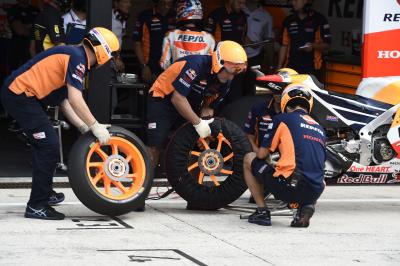Michelin explains tyre 'freeze' for 2018
It's not only MotoGP engine design that will be frozen for the 2018 season at the opening round in Qatar next weekend.
Michelin will not introduce any new tyre designs once the world championship is underway.
Last season the front tyre design changed from Mugello, round six, after a majority of riders voted in favour of the change.
It's not only MotoGP engine design that will be frozen for the 2018 season at the opening round in Qatar next weekend.
Michelin will not introduce any new tyre designs once the world championship is underway.
Last season the front tyre design changed from Mugello, round six, after a majority of riders voted in favour of the change.
"We want to keep stability in terms of tyres," said Piero Taramasso, manager of two-wheel motorsport for Michelin. "This is what the riders and teams asked us to do.
"So starting at the beginning of the season we will fix the front casing and the front profile, plus the rear casing and the rear profile. This will not change all season.
"And also the compounds. 80% of the compounds we will use this season are from last year, plus two or three new ones which we have been validating [in the pre-season tests]. So teams and riders will know the tyres very well.
"We will not change during the season, so they can work on the bike, the setting, the engine, without having a problem with tyres changing.
"Especially in the first year [2016], we wanted to develop very quickly, to try to give the best tyre as soon as possible. And the riders complained, 'the tyres change too much, they change the handling, this and this and this'.
"So this year, there will be no change. There will be stability of the tyres."
The new front compounds tested for use in 2018 are described as "quite hard… we want to use them at tracks where we faced some wear problems. It's a different way to mix the rubber, a different technology, just to be wear resistant.
"Here [in Qatar] we will bring one solution, the 'E', for the race as the hard option. And the second one [the 'X'] we will probably bring to other tracks like Argentina or Austin."
In total, Michelin will use around 7 different front compounds and 11-12 different rear compounds during the 19 rounds.
There are three events which require special attention this season - the new Buriram track, where an official pre-season test has been held, plus the resurfaced Silverstone and Barcelona circuits.
"Buriram, we needed to go. Barcelona has been resurfaced, so we have planned one test before and we will have data for that. Silverstone will also be resurfaced. We don't plan to do a test there, but we have an agreement with Dorna to bring four front specifications and four rear specifications, to be sure to have the right ones.
"For the other tracks, we have enough experience and data after two years to make the right tyres."
Taramasso conceded "from a Michelin point of view, we want to develop" but with no new tyres being introduced during 2018, Michelin's attention is already turning to 2019.
"If we want to bring a new solution - a new casing, new profile, new compound - we can test during the [official] IRTA tests, but these solutions can only be used for 2019," he said. "So we are still developing, but slower, and any [new tyres] we validate this year will only be for next year."
A change for 2018 in terms of Michelin's wet tyres is that they will all feature asymmetric compounds.
"All the rears are asymmetric. Last year we had some asymmetric tyres, some had a different compound on the left, some were the same compound [throughout]. This year they will be all asymmetric - specific for left-hand or right-hand circuits.
"So more made-to-measure for the track. More specific to the track, like we do for the rear slicks."
Alongside stability in tyre design, the remaining criticism sometimes heard from riders - 'quality control', meaning a difference in performance from tyres of the same design - is also being addressed.
"It's not easy to understand where this comes from. We need to work, this is our goal. We are working in the factory, in transport, to try to understand [how that affects the tyres], and of course, we keep statistics, which we then send to Dorna to prove that we improved compared to last year.
"So far, we had a small problem in Sepang, but this was just our mistake, because we left some tyres from last year's race in the containers at the Sepang circuit, and then we used them at the IRTA test. But probably the temperature in the container had gone up too high, and the tyre was not good.
"Then in Thailand and here [in Qatar], it has been good. So far, we have no issues. So I hope it will continue like this."
Being a single tyre supplier in top level motorsport is often a thankless task and, while Taramasso wants "people to speak about the tyres, but in a good way" he knows the reality is:
"When we do well, nobody speaks about the tyres, When something goes wrong, everybody speaks about the tyres. This is the way it has been forever!"
This season will see an increase in responsibility for Taramasso, following Nicolas Goubert's move from Michelin to head the new FIM MotoE World Cup.



![Johann Zarco, LCR, Honda RC213V, 2024 San Marino MotoGP, Misano, action [Gold & Goose]](https://cdn.crash.net/styles/thumbnail/s3/2024-09/GnG_1166323_HiRes.jpg?itok=vpgrU7Q4)

![Jack Miller, KTM Factory Racing, KTM RC16, San Marino MotoGP, Misano, action [Gold & Goose]](https://cdn.crash.net/styles/thumbnail/s3/2024-09/GnG_1167624_HiRes.jpg?itok=iz7mA4EQ)


![Fabio Quartararo, Monster Energy Yamaha Racing, Yamaha M1, 2024 MotoGP, Misano Test, action [Gold & Goose]](https://cdn.crash.net/styles/thumbnail/s3/2024-09/GnG_1168928_HiRes.jpg?itok=fcYSole_)
![Toprak Razgatlioglu, ROKiT BMW Motorrad, BMW M 1000 RR, Magny-Cours, WorldSBK [Gold & Goose]](https://cdn.crash.net/styles/thumbnail/s3/2024-09/GnG_1165133_HiRes.jpg?itok=GD5SVNVG)

